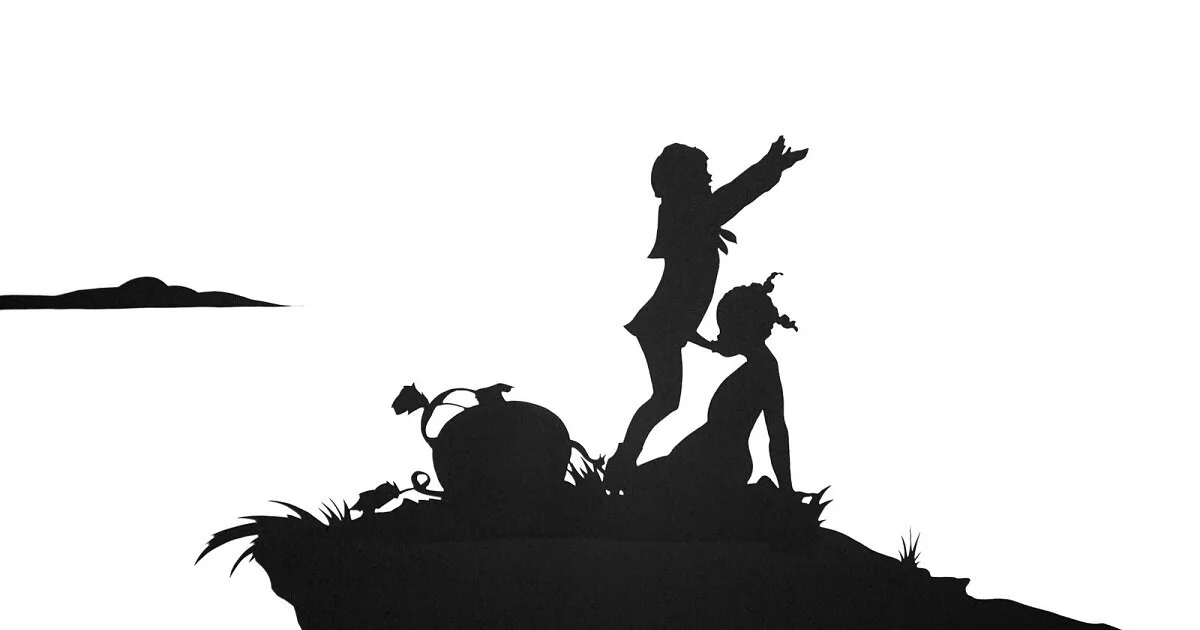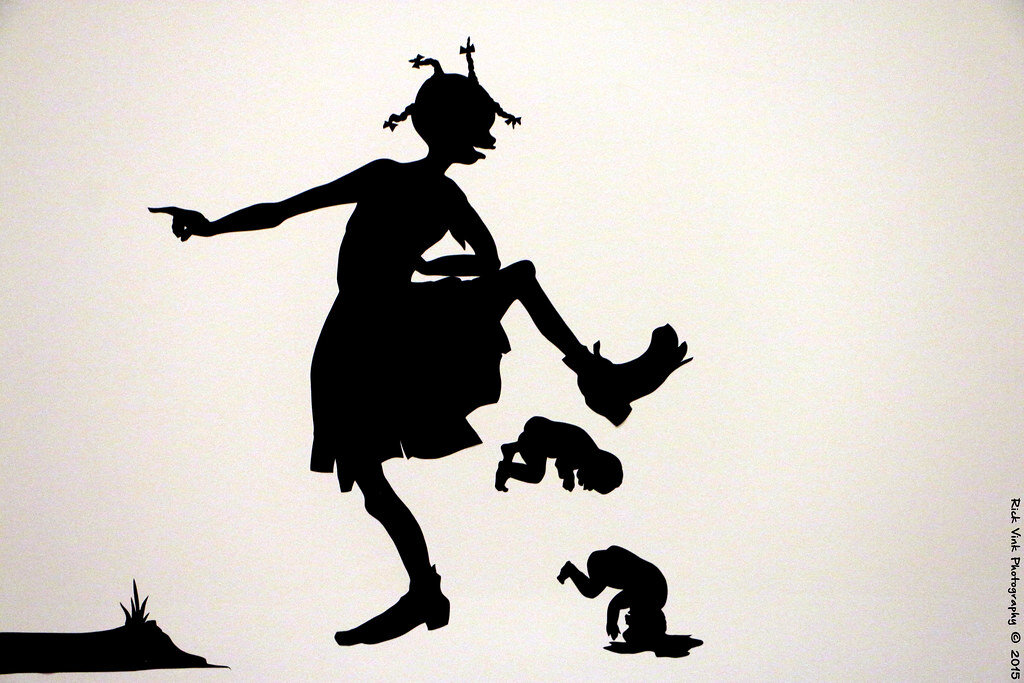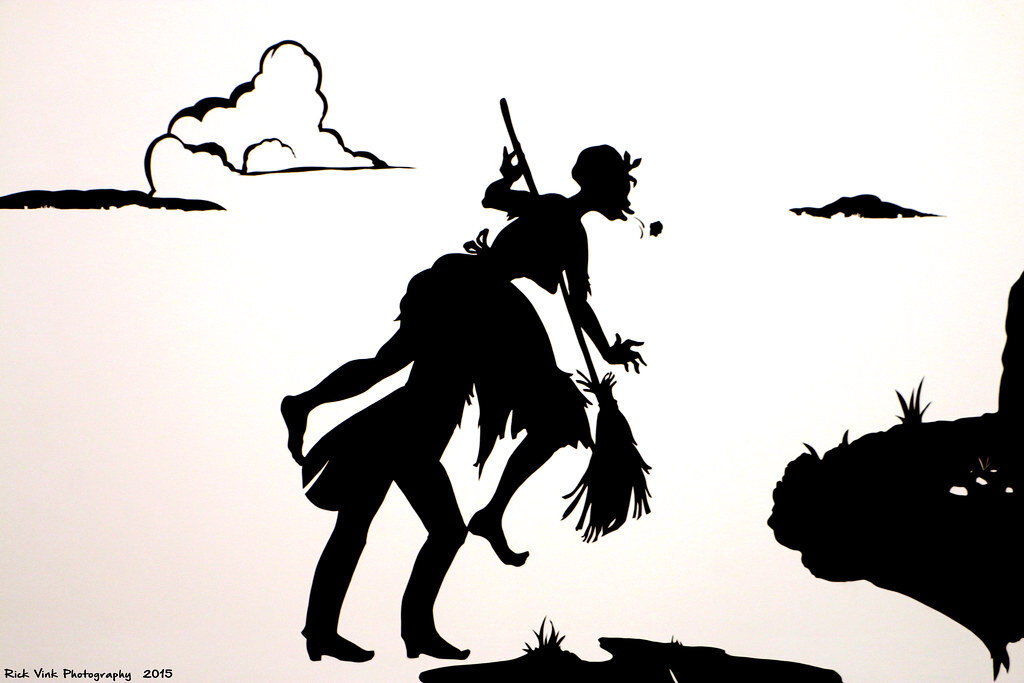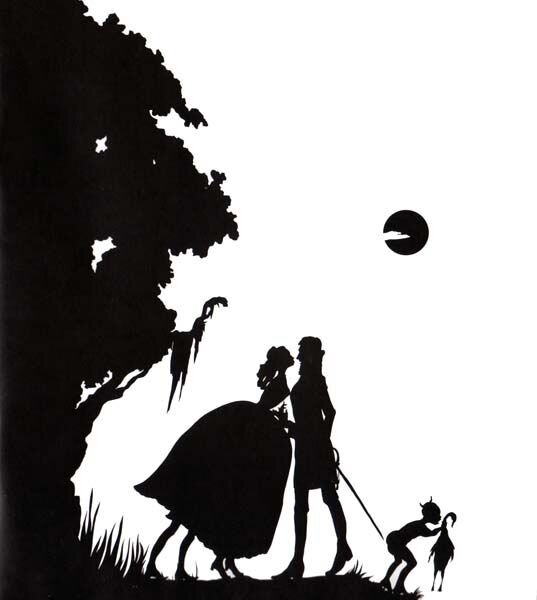Kara Walker's History Lesson
Many summers ago, I was walking up the stairs of a home in the Hamptons when I found myself face to face with an almost life-sized silhouette of a girl marching with a heavy flag. The elegance of the cut black paper against the gallery-white walls and the surprise of finding silhouette art in a house otherwise filled with colorful, complex paintings and sculptures (I’d passed Damien Hirst, Sue Williams and Chris Ofili on my way up), stopped me mid-step.
On closer inspection, I saw the girl was wearing men’s shoes and a fancy dress, and was about to step in a bucket of white liquid. She was black - distinct details of her silhouetted form told me that - such as the nappiness of her braided hair and the fullness of her nose and lips. Later I would reflect on the way the artist played with those learned signifiers and marvel at how a few carefully cut lines could recall an entire race and time period. The work was Untitled (Girl with Bucket) 1998, my first encounter with the work of artist Kara Walker.
Kara Walker, Untitled (Girl with Bucket), 1998
In her huge body of work, Walker confronts the way culturally constructed myths deliberately whitewash historical truths and reframe events to benefit the ruling class. She shocks, prods, explodes, confronts and challenges.
“I am always reflecting on the state of current events and the overlap of the historical and the mythic...””
She holds nothing back and, having the courage to court criticism, influences and advances crucial public discourse about historical meaning and myth making. (Both white and black critics have called her work negative, shameless and counter to the cause of racial equality. Betye Saar’s slam, “I felt the work… was sort of revolting and negative and a form of betrayal to the slaves, particularly woman and children, and that it was basically for the amusement and the investment of the white art establishment,” is an example).
A master of subversion, Walker plays with an astonishing range of normalized cultural motifs and artistic categories in her silhouettes, paintings, sculptures, monuments and films. Everything from romance novels to minstrel shows, pornography, current events and traditional painting genres get absorbed in her work. In this way she can comment on the present while using signifiers from the past. Her characterizations of the brutalizations and humiliations of enslaved figures at the hands of white masters and mistresses, which many initially found regressive, have become depressingly prescient in recent years.
In 1997 at 27, the artist received the MacArthur Genius grant, three years after she completed her MFA at RISD and shocked the art world with her first large scale silhouette, Gone: An Historical Romance of a Civil War As it Occurred B’tween the Dusky Thighs of One Young Negress and Her Heart.
Kara Walker, Gone: An Historical Romance of a Civil War As it Occurred B’tween the Dusky Thighs of One Young Negress and Her Heart, 1994. Shown here at MOMA in 2010.
Her works have been shown across the globe and can be found in the permanent collections of the Guggenheim, MOMA, The Metropolitan Museum of Art, the ICA and the MFA in Boston, The Tate Gallery, London and the Museo Nazionale delle Arti del XXI Secolo (MAXXI) in Rome.
In other words, she is a leading voice in the global dialogue on race, white supremacy, identity politics and historical representation. So that’s why, in the wake of July 4th, historically one of the most important days for our country and one plastered in patriotic storytelling, I’ve been thinking a lot about her.
Walker’s cut-paper silhouettes, like Untitled (Girl with Bucket) and her monumental sculptures like Sugar Baby, usurp the literary tropes and cultural stereotypes of the Antebellum South and radically upend them to address her primary themes of racism, gender, sexuality, violence, power and representation. She exploits the high art genre of History Painting used in the 18th and 19th centuries to showcase European strength around the world, by grouping her characters in room-spanning panoramas which tell stories of sadistic cruelty, injustice and pain against one group of people (slaves) at the hands of the other (slave owners) and mimicking it in cut forms.
The girl with the bucket was not alone, she is part of a larger narrative told over hundreds of works, but that day on the stairs and the days following when I stood transfixed in front of her, she drew me in and compelled me to consider her story, even as the form of the silhouette negated her individual features. Some of Walker’s panoramas unfold across multiple walls or fill entire rooms, like Gone and Slavery! Slavery! (See full titles in captions). Generous amounts of white space have the effect of provoking deep engagement with both the individual figures and the larger group, thereby taking power away from racist mythic generalizations.
Kara Walker: Slavery! Slavery! Presenting a GRAND and LIFELIKE Panoramic Journey into Picturesque Southern Slavery or “Life at ‘Ol’ Virginny’s Hole’ (sketches from Plantation Life)” See the Peculiar Institution as never before! All cut from black paper by the able hand of Kara Elizabeth Walker, an Emancipated Negress and leader in her Cause, 1997.
Walker is a professor, the Tepper Chair in Visual Arts at the Mason Gross School of the Arts at Rutgers, and her work is an ongoing history lesson.
Having suffered through the lifeless, timeline and memorization-heavy public school History curriculum for years, I’m a complete sucker for the artist’s layered, complicated, “giddy and sexed up” (her words) instruction. She reframes “history” from a linear sequence of carefully curated dates and facts to a chaotic, violent and ever-unfolding confusion of stories based on lived experience.
Kara Walker’s work helps me see history as a swirling unfurling cacophony rather than a long drawn out note.
When asked to choose a piece of work from MOMA’s collection to discuss with the BBC, culture critic Roxane Gay, opinion writer for the New York Times and author of many books including Bad Feminist, chose Walker’s enormous drawing Christ’s Entry Into Journalism. Taking in the 11 x 16 foot drawing, Gay remarked that “she has managed in a series of figures to depict the whole of African American history on one canvas…”
Kara Walker, Christ's Entry into Journalism, 2017
Plantation Belle Barbie
Kara Walker confronts and exposes divisive stereotypes and debunks myths perpetuated to make generations confuse the true lived experience of slaves with stories friendlier to the white ruling class. Confronting the Lost Cause myth which recast the horrors of slavery and the Civil War with a romantic ideal of “moonlight and magnolias”: grand houses, dashing Confederate soldiers, breezy plantation life, fancy dress and happy slaves (see Gone With the Wind).
Where at first you might spot a Scarlett O’Hara type southern belle, a slave is found being sodomized. Heads are carried on platters, sharp branches shoved down throats, massive erections brutalize soft flesh. Underage fellacio, two sets of legs under one hoop skirt, shit, piss, vomit, blood. It’s all part of Walker’s history lesson.
“One theme in my artwork is the idea that a Black subject in the present tense is a container for specific pathologies from the past and is continually growing and feeding off those maladies.”
Akin to the way Kehinde Wiley upends traditional European portraiture by placing unknown black men and women in historically significant paintings of famous figures, Kara Walker uses historical settings to address racism in the present.
Kara Walker, The moral arc of history ideally bends toward justice but just as soon as not curves back around towards barbarism, sadism and unrestrained chaos, 2010. Artwork ©Kara Walker, courtesy of Sikkema Jenkins & Co., New York.
Kara Walker, A Subtlety (the Marvelous Sugar Baby: an Homage to the unpaid and overworked Artisans who have refined our Sweet tastes from the cane fields to the Kitchens of the New World on the Occasion of the demolition of the Domino Sugar Refining Plant, 2014. Sugar, molasses, polystyrene.
Independence Day felt different this year, after the racial reckoning of last summer and the recent formalization of Juneteenth as a federal holiday. Think about the mess of ideas and narratives swirling around the year 1776 at the moment. We are under five years away from our country’s 250th birthday and Americans are viciously divided about the significance of that founding year. During the bloody insurrection of the capital on January 6th, many of the rioters carried “1776” flags with 13 stars, the original Betsy Ross design, which for some extreme groups celebrates a time when minorities and women had no voting power.
With more and more states moving to adopt laws that restrict access to voting for minority populations, coloring The Big Lie myth as a narrative in which minority voters caused an unwanted, fraudulent election outcome, we only need to open a news app to see the way myth making is alive and working to whitewash very recent historical events.
HB 3979, the Texas education bill which has become a model for other states, “tries to cleave off students from any feeling of historical responsibility—as if, with each generation, America were re-created, blameless and anew,” writes Benjamin Wallace-Wells in the New Yorker. In September of 2020 ex-President Trump followed suit, signing an executive order establishing the 1776 Commission to establish a revised curriculum of “patriotic education” for American school children, removing lessons that explain the role of slavery and the contribution of black Americans, lessons which he claimed taught students to “hate their country.”
That same month, Vogue released a special issue on the subject of Hope. Vogue invited influential contemporary artists to reflect on the theme. Kara Walker shared two watercolors, Mother and Daughter and The Last Limb, both made in 2020.
Kara Walker, The Last Limb, 2020
Kara Walker, Mother and Daughter, 2020
She wrote of her contributions, “Sitting down to make an intimate drawing is a conversation, a way of listening to what’s grumbling inside my body, and an attempt to transmit, nonverbally, an experience of being. It’s a hopeful act: an attentive and often surprising exercise I forget to do for long stretches. But when the world concentrates so much violence, ignorance and mind games into little digital devices we are compelled to carry, I am grateful to have this simple analog practice at my fingertips.”
The work of Kara Walker and other influential artists of color like Zanele Muholi, Kehinde Wiley, Simone Leigh, Tsalabala Self and Amy Sherald (to name just a very few) provides protection against the sugar coating of historical truths. Thanks to their contributions, I choose to believe the girl with the flag is walking into a different future than the one she marched toward when she was cut from black paper in 1998. Though the bucket full of white still threatens to douse her and challenge the course of her march, maybe she has more tools or more champions to help her navigate it. Even while everyone is talking at once, the important thing is people are talking. Artists are engaging the public in crucial and challenging conversations, cutting myths into pieces and reassembling them so we can see them more clearly up against our white white wall.




















